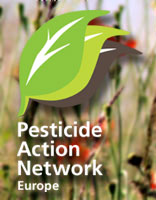4th July 2013
Brussels
PAN Europe challenges European Commission
to go further on neonicotinoids
Despite the important and historic step in the right direction, the European Commission’s partial and possibly temporary ban on neonicotinoids does not entirely follow European Food Safety Authority (EFSA)’s opinion. Many uses toxic to bees remain authorised. PAN Europe and the French rural organisation Confédération paysanne sent today a request for internal review of the ban regulation and will go to court if no total ban is obtained from the European Commission.
Environmentalist NGOs have applauded the April 2013 decision of the European Commission to ban 3 neonicotinoids insecticides, after 20 years of honey bees decline. But after the euphoria, analysis of the situation have shown that Commission only partially followed EFSA’s conclusions [1].
Maintaining winter cereals seed coating use of imidacloprid, thiamethoxam and clothianidin, will contaminate soils for years. Scientifically proven contamination of bee-attractive crops the following year [2] is not taken into account, despite EFSA’s warnings. Coated seeds’ sawing produces toxic dust that kills bees and contaminates the environment. Despite EFSA’s concerns, Commission decided, once again, to maintain use on winter cereal’s approval.
Neonicotinoids use in greenhouses has also been maintained. A recent Dutch study (Van Dijk et al. 2013 [3]) has put to light the highly negative impact of imidacloprid on surface water organisms in the Netherlands; Dutch Westland region is the most contaminated area of the Netherlands, precisely where the world’s most important concentration of greenhouses stands4. Greenhouses use of neonicotinoids thus harm the environment.
PAN Europe bees project coordinator Martin Dermine says “By maintaining the use of neonicotinoids spraying after blooming of crops and seed coating practices, Commission seems not taking into account less popular pollinators than honey bees! Bumblebees, solitary bees, butterflies nest in contaminated soils or use contaminated plant nesting material. Worst, this will continue despite EFSA’s concerns. Moreover, these chemicals can remain for more than one decade in the environment and lead to long-term bees’ exposure through contaminated nectar, pollen, soils, water, etc.”.
For these reasons
[4], thanks to the Aarhus convention, Pesticide Action Network Europe and French rural organisation Confédération paysanne sent a letter to the European Commission, requesting an internal review of neonicotinoids’ ban regulation 485/2013 and a review of the omission to act to protect pollinators. Both organisations will go to Luxembourg European Court of Justice in case the European Commission does not take action to protect all pollinators and the environment by banning all neonicotinoids’ uses.
— ENDS —
Further information
2. Bonmatin, JM; Moineau, I; Charvet, R; Colin, ME; Fleche, C; Bengsch. Behaviour of imidacloprid in fields. Toxicity for honeybees, ER in Environmental chemistry: green chemistry and pollutants in ecosystems (Ed. Lichtfouse, E; Schwarzbauer, J; Robert, D; Lichtfouse, E; Schwarzbauer, J; Robert, D) (2005) 483-494
3. Van Dijk, T.C., Van Staalduinen M.A, Van der Sluijs, J.P. Macro-invertebrate decline in surface water polluted with imidacloprid, PLoS One, 1 May 2013
For further information please contact:
Martin Dermine, martin@pan-europe.info, tel: +32 (0)486 32 99 92.
< Back


